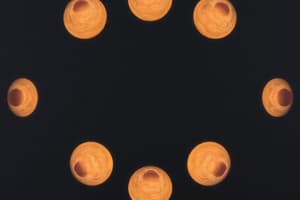Podcast
Questions and Answers
Explain the cell cycle.
Explain the cell cycle.
The cell cycle is a series of events that takes place from one cell division to the next. It involves interphase, mitosis, and the division of the cell.
Define mitosis and explain why it is important.
Define mitosis and explain why it is important.
Mitosis is the process in which the nucleus divides to form two identical nuclei. It allows growth and replaces worn out or damaged cells.
List and explain each step of mitosis.
List and explain each step of mitosis.
Prophase, Metaphase, Anaphase, Telophase.
What happens during prophase?
What happens during prophase?
What happens during metaphase?
What happens during metaphase?
What happens during anaphase?
What happens during anaphase?
What happens during telophase?
What happens during telophase?
Define 'chromosome' and explain its role in mitosis.
Define 'chromosome' and explain its role in mitosis.
Define 'sexual reproduction'.
Define 'sexual reproduction'.
Give two examples of asexual reproduction and explain each one.
Give two examples of asexual reproduction and explain each one.
What is a sperm?
What is a sperm?
What is an egg?
What is an egg?
Define 'fertilization'.
Define 'fertilization'.
What is a zygote?
What is a zygote?
Define diploid cells.
Define diploid cells.
Define haploid cells.
Define haploid cells.
Compare and contrast diploid and haploid cells.
Compare and contrast diploid and haploid cells.
Define meiosis and explain why it is important.
Define meiosis and explain why it is important.
List and explain each step of meiosis I and meiosis II.
List and explain each step of meiosis I and meiosis II.
Explain why there are two divisions of meiosis.
Explain why there are two divisions of meiosis.
Define DNA.
Define DNA.
Define a gene.
Define a gene.
Define mutation.
Define mutation.
Identify the nitrogen bases of a DNA molecule.
Identify the nitrogen bases of a DNA molecule.
Flashcards are hidden until you start studying
Study Notes
The Cell Cycle
- A sequence of events from one cell division to the next.
- Comprises three main stages: interphase, mitosis, and cytokinesis.
Mitosis
- Defined as the process of nucleus division to create two identical nuclei.
- Consists of four phases: prophase, metaphase, anaphase, and telophase.
- Essential for growth, tissue repair, and asexual reproduction in certain organisms.
Phases of Mitosis
- Prophase: Chromatid pairs become visible; spindle fibers begin to form.
- Metaphase: Chromatid pairs align at the cell's equatorial plane.
- Anaphase: Chromatids separate and move towards opposite poles of the cell.
- Telophase: Cytoplasm starts to divide and the nuclear membrane re-forms.
Chromosomes
- Structures in the nucleus housing hereditary material.
- Each chromosome duplicates during interphase to prepare for mitosis, ensuring equal distribution into daughter cells.
Reproductive Processes
- Sexual Reproduction: Involves two organisms merging their sex cells (sperm and egg).
- Asexual Reproduction: New organisms arise from a single parent via mitosis.
- Budding: New organism develops from the parent and detaches once mature.
- Regeneration: Body parts regrow through mitosis and cell division.
Key Reproductive Cells
- Sperm: Male sex cell produced in reproductive organs.
- Egg: Female sex cell produced in reproductive organs.
- Fertilization: Occurs when an egg unites with a sperm, forming a zygote.
- Zygote: The initial cell resulting from fertilization.
Diploid and Haploid Cells
- Diploid: Formed through mitosis; contain 46 chromosomes; examples include body cells like blood and skin.
- Haploid: Formed through meiosis; contain 23 chromosomes; examples are sex cells (sperm and egg).
- Key differences: Diploid cells are body cells, while haploid cells are reproductive cells.
Meiosis
- A specialized cell division that produces haploid cells for sexual reproduction.
- Essential for preventing chromosome overflow in offspring, ensuring genetic diversity through reduction in chromosome number.
Steps of Meiosis
- Meiosis I:
- Prophase I: Duplicated chromosomes pair up with their counterparts.
- Metaphase I: Homologous chromosome pairs align at the cell center.
- Anaphase I: Chromosome pairs separate to opposite ends.
- Telophase I: Cytoplasm divides, resulting in two new cells.
- Meiosis II:
- Prophase II: Chromosomes condense; spindle fibers form in each new cell.
- Metaphase II: Duplicated chromosomes line up individually at the cell center.
- Anaphase II: Centromeres split, and chromatids move to opposite ends.
- Telophase II: Cytoplasm divides, forming four haploid cells.
Importance of Two Divisions in Meiosis
- Ensures the creation of haploid cells to maintain proper chromosome numbers in sexual reproduction.
- Essential for genetic variation and successful reproduction.
DNA and Genes
- DNA: Contains genetic instructions for an organism's development and function.
- Gene: Specific sequence of DNA that provides instructions for synthesizing a particular protein.
Mutations
- Refers to permanent alterations in the DNA sequence of a gene or chromosome, which can affect an organism's traits and functions.
Nitrogen Bases of DNA
- Four bases: Adenine (A), Thymine (T), Cytosine (C), and Guanine (G).
- Base pairing rules: Adenine pairs with Thymine and Cytosine pairs with Guanine, maintaining equal amounts in the DNA molecule.
Studying That Suits You
Use AI to generate personalized quizzes and flashcards to suit your learning preferences.




